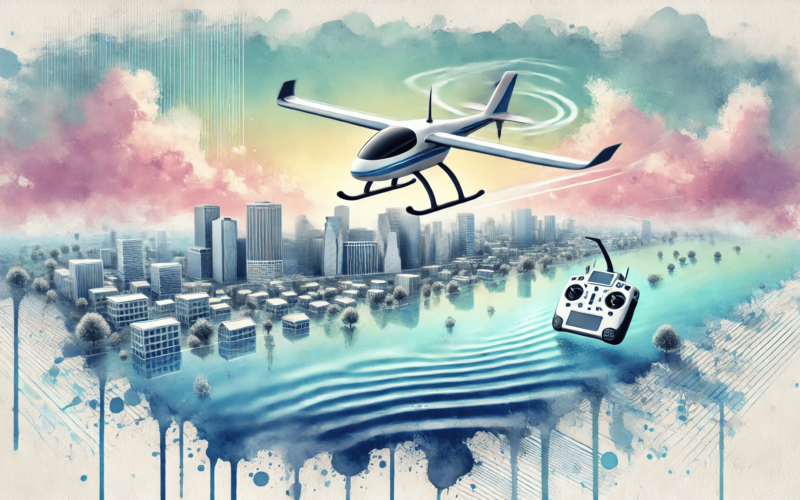Radio-controlled aircraft models have long ceased to be just a hobby. Today, they are actively used in rescue operations, where they become indispensable assistants. These compact but powerful devices play an important role in situations where other rescue methods are ineffective. One of the main areas of application is the search and rescue of people in hard-to-reach places, which is a real breakthrough in this area.
Rescue operations often face difficulties due to natural and territorial constraints, such as mountainous areas or flooded areas. In such cases, radio-controlled models of aircraft are incredibly useful. They are able to penetrateareas that cannot be reached by conventional helicopters or rescue teams. Flying in conditions of limited visibility and high terrain complexity, these vehicles perform important reconnaissance missions, transmitting up-to-date information about the situation on the ground in real time.
Modern radio-controlled models are equipped with advanced cameras, thermal imagers and sensors, which significantlyexpands their capabilities. They can not only detect people, but also assess the scale of the disaster, which allows you to quickly make the right decisions. These models also played a role in the development of new technologies that have found application in the aircraft industry, including improved control systems and composite materials that are actively used in the creation of real aircraft. Thus, their contribution to the development of aviation cannot be underestimated. Such devices are actively used when searching for victims of natural disasters or in remote areas where traditional rescue methods are ineffective.
How radio-controlled aircraft models are used in rescue missions
Radio-controlled aircraft are beginning to play an increasingly important role in rescue operations due to their unique characteristics. In situations where rescue operations are difficult due to the inaccessibility of the terrain, they can be used for aerial photography and monitoring. One of the most striking examples is the use of such models in mountainous areas, where rescuers face access and time constraints. In such cases, radio-controlled aircraft help to quickly assess the situation and prepare rescue teams for action.
In addition, radio-controlled models are actively used in situations where it is necessary to conduct reconnaissance in low visibility or adverse weather conditions. For example, in areas with heavy fog or flooding, when even a drone can’t always work effectively, such aircraft are the best option for collecting information. They can be equipped with various sensors and cameras, which allows you to accurately determine the location of people or assess the extent of destruction. In this context, radio-controlled aircraft open up new opportunities for search and rescue operations.
Special attention should be paid to their use in search and rescue operations in Arctic regions where conditions are extreme. The use of radio-controlled models in such conditions allows exploration without the need to introduce people or expensive equipment into the risk zone. These devices help not only to find the missing, but also to quickly assess the degree of danger for rescuers, minimizing human losses and speeding up assistance.
Advantages of radio-controlled models for monitoring and exploration
Radio-controlled aircraft models offer many advantages that make them indispensable in rescue operations. One of the most obvious advantages is high maneuverability, which allows the models to fly in conditions where other types of transport and equipment are limited. Thanks to their compact size and a variety of specialized sensors, these aircraft can collect information that would normally be unavailable. This, in turn, allows you to effectively plan further actions and quickly respond to changes in the situation.
In addition, radio-controlled aircraft provide significant savings in money and time. Unlike helicopters, their operation does not require large fuel and maintenance costs. They can be quickly deployed at any point where the need arises, and immediately begin to complete the tasks set. This is especially important in emergency situations, when every minute counts.
Another undeniable advantage is their ability to operate in environments where traditional means of rescue are not possible. For example, in mountainous or swampy areas where helicopters cannot safely land, radio-controlled models can continue to perform their task. Thus, their use not only expands the possibilities of search and rescue operations, but also significantly increases the chance of successful completion of the mission.
Radio-controlled model technologies for rescue missions
Radio-controlled aircraft models have a set of high-tech features that make them indispensable in search and rescue operations. Equipped with state-of-the-art sensors and cameras, these models can collect and transmit important information in real time, which significantly improves the effectiveness of missions. The technologies used in such aircraft range from thermal imaging cameras to a GPS system, which allows you to accurately determine the location of victims and transmit this data to rescuers. All these technologies provide not only safety, but also increased accuracy during rescue operations in difficult conditions.
One of the key advantages of radio-controlled models is the ability to quickly deploy them and work in various conditions. They can be used to monitor an area, for example, after natural disasters such as earthquakes or floods. To do this, models are equipped with special cameras that can work in all weather conditions, even in fog or heavy rain. This approach allows you to quickly assess the situation on the spot and quickly make a decision on rescue actions.
When it comes to complex tasks, such as searching for people in flooded or mountainous areas, radio-controlled aircraft models provide rescuers with unique capabilities. They can easily enter areas where traditional rescue methods are ineffective. For example, they can be used for:
- Surveys of areas after floods where it is difficult to find people manually.
- Aerial surveys for monitoring major earthquake damage.
- Perform high-speed exploration in hard-to-reach mountain areas.
- Conducting search operations in areas where the probability of using helicopters is extremely low.
These opportunities significantly increase the chances of successful rescue of people, as well as provide an opportunity to quickly make a decision on further planning of the rescue operation.
Application of radio-controlled models in rescue operations
Radio-controlled aircraft models have become an important tool in search and rescue missions in recent years. These technologies allow rapid exploration and monitoring of hard-to-reach and dangerous areas, speeding up the rescue process. Models are able to deliver rescue equipment or messages to the most remote areas where traditional delivery methods are not possible. Their use significantly increases the efficiency of rescue teams and ensures safety at disaster sites.
One of the key features of radio-controlled aircraft is their ability to operate in conditions where helicopters or other rescue vehicles cannot be used. This is important when it comes to complex landscapes, such as mountainous areas, forests, or areas with destroyed infrastructure. Such models provide not only greater maneuverability, but also the ability to conduct real-time reconnaissance, transmitting accurate data from the scene. This helps you make faster and more informed decisions to save people.
In addition, the use of radio-controlled aircraft models reduces the risks to the lives of rescuers. Often, a rescue operation requires being in dangerous or inaccessible areas where there is a threat to human health and life. Aircraft models, with their ability to fly at low altitudes and maneuver in tight spaces, minimize the need for personnel to work in dangerous conditions. This makes rescue operations safer and more efficient.
Advantages of using radio-controlled models in rescue operations
Radio-controlled aircraft models have many unique characteristics that make them indispensable in rescue operations. One of their main advantages is the ability to work in the most difficult conditions, where other types of transport and equipment are inefficient. They can quickly deliver the necessary equipment or conduct reconnaissance in hard-to-reach places. It is important to note that such models provide fast data transmission and improved visibility on the scene, which speeds up the decision-making process.
Such technologies allow rescuers to collect and analyze information in real time, without risking their lives. This is extremely important in a situation where every minute counts. Radio-controlled aircraft models are equipped with various sensors and cameras, which makes it possible to accurately monitor the situation on the spot. Thanks to this data, rescuers can quickly respond and organize rescue operations with minimal losses.
In general, the use of radio-controlled aircraft models significantly increases the probability of successful completion of rescue operations. Such models are becoming an important addition to traditional methods, expanding the capabilities of teams and reducing the risks for human victims. Every rescue operation that involves these technologies becomes more successful and faster.
Questions and answers
Radio-controlled aircraft models help to quickly survey hard-to-reach areas and transmit real-time data, which speeds up rescue operations.
Radio-controlled aircraft models allow you to operate in difficult and dangerous conditions, such as mountainous areas or floods, where helicopters cannot operate effectively.
The use of radio-controlled aircraft allows rescuers to collect information from the scene without having to physically be in dangerous areas, which reduces the risks to their lives.

